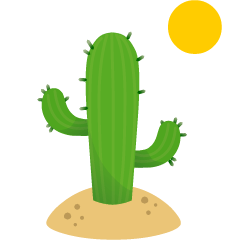🏜️Meaning and Description
This emoji 🏜 paints a vivid picture of a vast desert landscape. Dominated by golden hues, this emoji showcases a barren terrain with a single cactus🌵 standing tall. The background is the sky with a golden sun hanging.
Deserts are regions of the Earth that receive very little rainfall🌧, usually less than 25 centimeters (10 inches) per year. Deserts cover about one-fifth of the land surface and can be found on every continent. Some of the most famous deserts in the world are the Sahara, the Gobi, the Atacama, and the Antarctic.
It's a versatile symbol used in various contexts. Primarily, it represents a location or destination that is in or near a desert. In addition, it can indicate hot🥵, arid conditions, often used to describe a place or situation that's barren or devoid of activity.
On a lighter note, it's also a favorite among travelers and adventure seekers, hinting at a desert vacation or a thrilling dune bashing experience🚙. Additionally, in the world of metaphors, this emoji can signify feeling deserted or alone. The emoji can also be used in more serious contexts, like discussing desertification, climate change, or the importance of conserving desert ecosystems.
Deserts are regions of the Earth that receive very little rainfall🌧, usually less than 25 centimeters (10 inches) per year. Deserts cover about one-fifth of the land surface and can be found on every continent. Some of the most famous deserts in the world are the Sahara, the Gobi, the Atacama, and the Antarctic.
It's a versatile symbol used in various contexts. Primarily, it represents a location or destination that is in or near a desert. In addition, it can indicate hot🥵, arid conditions, often used to describe a place or situation that's barren or devoid of activity.
On a lighter note, it's also a favorite among travelers and adventure seekers, hinting at a desert vacation or a thrilling dune bashing experience🚙. Additionally, in the world of metaphors, this emoji can signify feeling deserted or alone. The emoji can also be used in more serious contexts, like discussing desertification, climate change, or the importance of conserving desert ecosystems.
💡Extended reading and popular science
The current 🏜️ is a variant Emoji (emoji style, displaying colorful symbols on most new platforms), and it has two corresponding Emoji: 🏜 (basic Emoji without variant symbols) and 🏜︎ (text style, displaying black and white symbols on some old platforms). 🏜️ (emoji style) = 🏜 (base style) + emoji style
The meaning of emoji symbol 🏜️ is desert, it is related to , it can be found in emoji category: "🚌 Travel & Places" - "🌋 Geography".
🏜️Examples and Usage
🏜️Images from Various Manufacturers
🏜️Basic Information
| Emoji: | 🏜️ |
| Shortname: | desert |
| Apple Name: | Desert |
| Codepoint: | U+1F3DC FE0F Copy |
| Decimal: | ALT+127964 ALT+65039 |
| Unicode Version: | None |
| Emoji Version: | 1.0 (2015-06-09) |
| Categories: | 🚌 Travel & Places |
| Sub Categories: | 🌋 Geography |
| Keywords: | desert |
| Proposal: | L2/11‑052 |
👨💻Unicode Information (Advanced Usage)
🏜️Trend Chart
🏜️Popularity rating over time
🏜️See also
🏜️Extended Content
🏜️More Languages
| Language | Short Name & Link |
|---|---|
| Arabic | 🏜️ صحراء |
| Bulgarian | 🏜️ пустиня |
| Chinese, Simplified | 🏜️ 沙漠 |
| Chinese, Traditional | 🏜️ 沙漠 |
| Croatian | 🏜️ pustinja |
| Czech | 🏜️ poušť |
| Danish | 🏜️ ørken |
| Dutch | 🏜️ woestijn |
| Filipino | 🏜️ disyerto |
| Finnish | 🏜️ autiomaa |
Search
Recents
No recent use emoji
Emojify...
Emojify Success



















